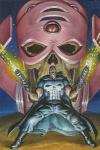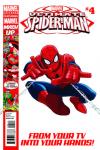|

By Jim Beard
Writer Frank Tieri’s storytelling experience covers a little bit of everything, including such Marvel projects as DEADPOOL, IRON MAN, WOLVERINE plus events like Civil War and World War Hulk. These days he’s projecting gun-toting vigilante Frank Castle into the outer reaches in SPACE: PUNISHER and exploring new worlds with the animated “Ultimate Spider-Man” on TV.
So, he’s a busy guy, sure, but we convinced him his legion of fans would be richer for knowing his thoughts on his current work.
Marvel.com: What about Frank Castle as a character draws you into his world?
Frank Tieri: Most people will look at my career and say I’ve always been drawn to so-called “tough guy” characters or villains. But the truth is, those tend to be the most flawed characters—and that’s what I’m interested in. It’s the flaws in characters I like to play with.
And to me, there’s no more flawed character I can think of than The Punisher; in fact, I’d say Frank Castle may very well be the saddest character in all of comics. If you think about it, he’s fighting a fight he can never really win. The death of his family cut out a piece of his heart and no matter what he does, no matter how many mobsters, criminals, super villains, etc. he kills, he can never get it back. And yet he does what he does anyway. Kind of heartbreaking, really.
Marvel.com: What was your original objective for the SPACE: PUNISHER series?
Frank Tieri: To be honest, I’d have to say the objective changed for SPACE: PUNISHER right in the middle of the pitch. As I’ve said, this was originally my pitch for the regular Punisher series. An intergalactic Mafia would’ve started to set their sights on Earth, something they did would’ve gotten the Punisher’s attention and he would’ve rocketed off into space after them. Well, once Marvel decided they liked the idea enough to make this its own thing, then the objective of what I needed to do changed. Now, this wasn’t merely an arc on a book; now this was to be a kind of flagship title to a potential whole new franchise.
Now I get to play God—no continuity to worry about other than the one I was creating—and it’s really been a blast.
Marvel.com: In what ways do you feel a guy like The Punisher fits in best with the science fiction genre?
Frank Tieri: The most important thing at all times had to be that this was a Punisher story. That this, no matter where we put the story or what crazy things we did, at its core had to be a story about a man obsessed with getting revenge on those that murdered his family. Once you have that, everything else is just window dressing and you can really set the story anywhere to fit just about any genre. For example, can you imagine the Punisher story set as a Western? I sure as hell can.
Marvel.com: What's coming up in SPACE: PUNISHER #2, out August 8, that you're really excited about?
Frank Tieri: There are two major things that happen in issue #2 that are really important for the rest of the series:
One, Frank encounters The Hulk for the first time. The Hulk is sort of the universe’s Moby Dick, flying around the universe, leaving a path of destruction in his wake. He’ll play a very important part later in the series.
Two, we learn the identity of the true force behind the Sixth Fingered Hand. We know about the six capos who serve as front men for the organization—Doc Ock, Green Goblin, Ultron, Magneto, Red Skull and the recently deceased Sym-Brood-ant Queen—but the real force behind them, the true puppet masters who really control everything, they’ll be revealed by issue’s end. And what a reveal it is.
Marvel.com: Speaking of aliens, what's your philosophy in creating them? Where do you start?
Frank Tieri: I guess you can say my approach to creating aliens in the SPACE: PUNISHER world was that no matter how crazy and bizarre we made them, they had to at least make sense on some level. So Rhino became a rhino man, Doc Ock had actual octopus arms, Barracuda was turned into a gangsta fish-man, etc.
Even with the more complex stuff, there was a reason behind it. Like with the Sym-Brood-ants, that just came to me. The Venom symbiotes and the Brood, both parasitic races, living off each other. I just thought it worked.
And hell, let’s admit it: they look really friggin’ cool.
Marvel.com: No argument there! So, heading back to Earth, what appealed to you about getting involved with the “Ultimate Spider-Man” animated show?
Frank Tieri: I’ve always wanted to get involved in animation. Comics, video games, TV, movies—I don’t think you should limit yourself when it comes to the different mediums you can tell your stories in. Especially in this day and age.
So when the opportunity arose with “Ultimate Spider-Man” and not only would I get to work on a Spider-man cartoon, but also one that was taking a unique approach and I’d get to work with Joe Kelly and the Man of Action guys? Hell, I couldn’t sign up fast enough. It’s really been a great experience, I have to say.
Marvel.com: As a writer, do you have a different approach to handling comic scripts, animation scripts and video game stories?
Frank Tieri: Very different processes when creating each of them. Very different writing muscles. I think the one thing you need to recognize right away is that although there’s a lot of overlap as far as fans go, they’re looking for different things from each different medium. So with that in mind, you definitely need to make adjustments to the medium you’re working on and write accordingly.
Or in other words—and this is probably the most important thing when it comes to an entertainment industry of any kind: know your audience.
Marvel.com: You've worked with a ton of great artists on your Marvel books; what's something you really prize in that collaboration between writer and artist?
Frank Tieri: I think the main thing that’s more important to me than anything when it comes to my collaborators, whether it’s with artists, or even co-writers and editors, is that the project comes first. Which means the attitudes and the egos stay at the door; harder said than done, in some cases, believe me. My motto has always been “best idea wins” and I don’t care if it comes from me, the artist, the editor or the janitor. Wherever the best idea comes from is the one that sees the light of day. And when collaborators are all onboard with that, I truly believe that’s when the best work gets done.
Case in point: with SPACE: PUNISHER, I have to be cryptic about this, but while the main ending was always going to be what it was, there is an aspect to it that was completely editor Steve Wacker’s idea. And it absolutely makes my original ending work better—and that’s the one we went with.
|









